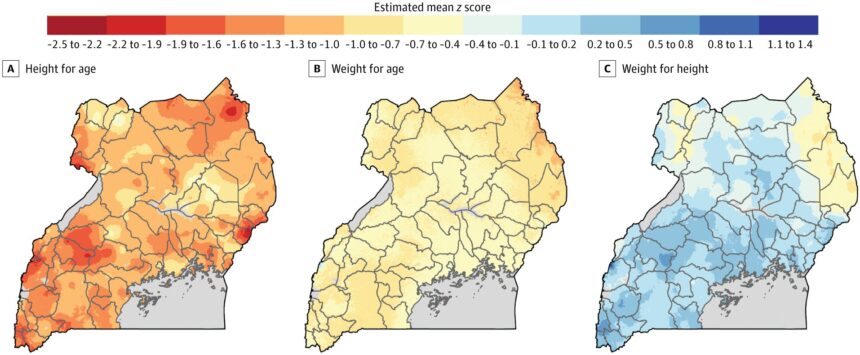Rainfall and long-term water availability in a region before a woman becomes pregnant and during pregnancy predicted future growth outcomes of children in Uganda, according to recent research conducted by a team from the Penn State Health Milton S. Hershey Medical Center and the Penn State College of Medicine.
The study found that women living in areas that did not receive adequate rainfall or experienced drought were more likely to give birth to children who did not grow at the expected rate for their age between birth and age 5. These children, who were under-nourished and lagging in their growth, were more vulnerable to infections and could experience cognitive, physical, and metabolic developmental impairments.
Environmental factors, such as rainfall, play a crucial role in food availability, which in turn affects a woman’s nutritional status before and during pregnancy. Insufficient food intake or under-nourishment in the mother can have a detrimental impact on the child, leading to low birth weight or growth faltering.
Published in the journal JAMA Network Open, the findings of the study could potentially influence the development of precision public health programs aimed at improving women’s nutrition and enhancing children’s nutritional outcomes both at birth and later in life.
Lead author of the study, Paddy Ssentongo, an infectious disease fellow at Penn State Health Milton S. Hershey Medical Center, emphasized the significance of considering longer-term weather dynamics and their effects on child nutrition status. The study aimed to predict the likelihood of children being malnourished based on specific environmental conditions during pregnancy and birth.
Children who experience growth faltering, such as stunting or wasting, often exhibit signs of these conditions shortly after birth. Stunting is a response to poor dietary intake or repeated illness, while wasting can be an acute reaction to undernutrition.
While previous research has focused on economic status and food availability as risk factors for malnutrition, this study delved into the impact of environmental factors like rainfall, drought, temperature, and topography on children’s nutrition in Uganda.
Analyzing data from the 2016 Ugandan Demographic and Health Survey, the researchers assessed over 5,200 children under the age of 5 to determine their growth status. The study revealed a high prevalence of malnutrition in Uganda, with significant numbers of children experiencing stunting, underweight, and wasting.
By examining meteorological and environmental factors at a village level, the researchers found a correlation between rainfall patterns and childhood malnutrition outcomes. Higher rainfall before birth was associated with a lower risk of malnutrition, while drought conditions increased the likelihood of malnutrition in children.
The study also highlighted the unexpected finding that poverty was not a significant factor in poor growth outcomes, challenging the assumption that socioeconomic status alone drives malnutrition.
Understanding how environmental factors influence children’s nutrition and growth outcomes can guide the development of targeted public health programs to address these issues effectively. By focusing on improving water availability and nutrition for pregnant women, interventions can be designed to prevent malnutrition in children from an early age, setting them up for healthier lives.
The research underscores the importance of considering environmental factors in public health initiatives and emphasizes the potential for proactive measures to combat childhood malnutrition in resource-constrained settings like Uganda.








